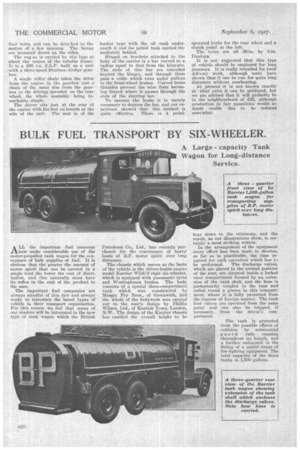BULK FUEL TRANSPORT BY SIX-WHEELER.
Page 44

If you've noticed an error in this article please click here to report it so we can fix it.
A Large capacity Tank ' Wagon for Long-distance Service.
ALL the important fuel concerns now make considerable use of the motor-propelled tank wagon for the conveyance of bulk supplies of fuel. It is obvious that the greater the amount of motor spirit that can be carried in a single load the lower the cost of distribution, and this naturally must have its reflex in the cost of the product to the user.
The important fuel companies are always mindful of this fact and always ready to introduce the latest types of vehicle in their transport organization. For this reason we feel that many of our readers will be interested in the new type of tank wagon which the British Petroleum Co., Ltd., has recently purchased for the conveyance of heavy loads of B.P. motor spirit over long distances.
The chassis which serves as the basis of the vehicle is the driver-beside-engine model Karrier WL6/2 rigid six-wheeler, which is equipped with pneumatic tyres and Westinghouse brakes. The body consists of a special three-compartment tank which was constructed by Messrs. Fry Bros., of Greenwich, and the whole of the bodywork was carried out to the user's design by Philip Wilson, Ltd., of Kentish Town, London, N.W. The design of the Karrier chassis has enabled the overall height to be kept down to the, minimum, and the result, as our illustrations show, is certainly a most striking vehicle.
In the arrangement of the equipment every effort has been made to shorten, so far as is practicable, the time required for each operation which has to be Performed. The discharge valves, which are placed in the normal position at the rear, are situated inside a locked steel compartment formed by an extension of the tank shell, and the hose is permanently coupled to the taps and coiled round a groove in this compartment, where it is fully protected from the ingress of foreign matter. 'The tank foot valves are operated from the same point and can also be tripped, if necessary, from the driver's compartment.
The tank is protected from the possible effects of collision by substantial guard rails running throughout its length, and a further safeguard is the fitting of a useful range of lire-fighting equipment. The total capacity of the three tanks is 1,500 gallons.




































































































